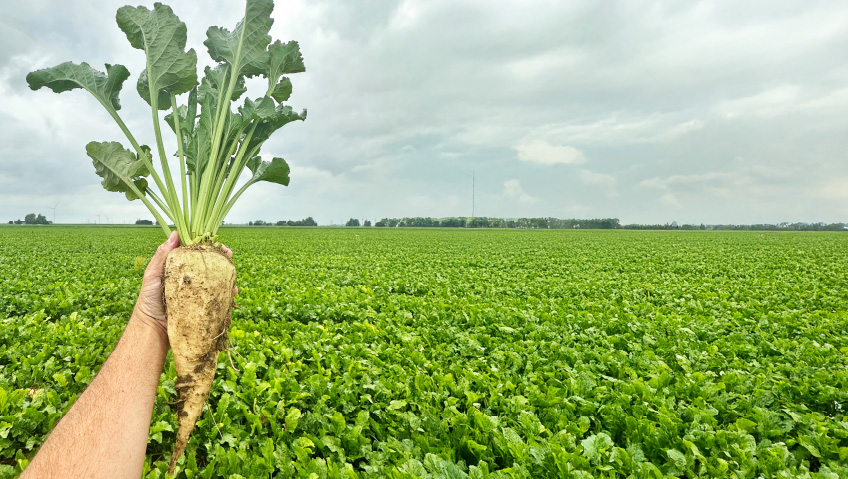A grower-owned cooperative, Michigan Sugar Company is headquartered in Bay City, Michigan, with sugar beet processing facilities in Bay City, Caro, Croswell and Sebewaing, Michigan; warehouse facilities in Bay City, Bridgeport, and Carrollton, Michigan, as well as Fremont and Findlay, Ohio; a production facility in Toledo, Ohio; and 10 sugar beet piling stations in Michigan and Ontario.
The company’s roots go back to 1906, when six smaller sugar companies merged operations. Nearly a century later, in 2002, it became a grower-owned cooperative, and two years later, in 2004, merged with Monitor Sugar Company.
Today, approximately 865 grower-owners in counties throughout Michigan and Ontario plant and harvest about 140,000 acres of sugar beets. They are sliced in the factories and turned into 1.3 billion pounds of sugar annually, which is sold under the Pioneer brand in various forms ranging from granulated and powdered sugars to liquid and brown sugars. These products find their way to retail and food service providers, as well as multi-national food processors. Co-products, including pulp, molasses, betaine, and raffinate, are used as animal feed supplements, so there is zero waste in the company’s operations.
The third largest of eight sugar beet processing companies in the U.S., Michigan Sugar Company is an important economic driver for the region. It has 1,000 year-round employees and an additional 1,100 seasonal workers, who may work up to nine months a year, with an annual payroll of nearly $90 million, making it one of the largest employers in the Great Lakes Bay and Thumb regions of Michigan. The company’s annual local economic impact is more than $700 million.
To learn more, we spoke with President and CEO Neil Juhnke, who joined the company in April 2023, bringing with him a wealth of experience in the agribusiness sector stretching back to 1990, when he began working for the American Crystal Sugar Company. We also spoke with Rob Clark, Senior Director of Communications and Community Relations, who joined the company eight years ago and worked through the pandemic.
“Our employees were deemed essential, as sugar is an important food product for consumers,” Clark explains. “The sugar industry rose to the challenge and the store shelves never lacked sugar, even when there were other shortages.”
The power of cooperative problem solving
When the pine lumber barons departed from the Saginaw Valley in the 1880s, they left behind huge tracts of stump-filled land, making the area virtually unusable, leading state and local leaders to search for a solution that would form a sustainable, economic base.
Enter the sugar beet.
Joseph Seemann, a Saginaw Valley printer who had travelled to Europe in 1884, observed how well sugar beets were growing there, and returned with seed samples, which he showed to Dr. Robert Kedzie, a chemistry professor at the Michigan State Agriculture College (now Michigan State University). Kedzie expressed great enthusiasm for the prospect of sugar beet farming in Michigan.
“Three crops of beets,” he is recorded as saying, “grown in three successive years, are worth as much as one crop of pine trees which took 100 years to mature.”
In 1887, the industry got its official start when the state legislature passed a bill offering sugar beet processors a bounty of one cent per pound of sugar, providing the farmers received four dollars per ton of beets yielding 12 percent sugar content.
Over the next century, there was tremendous growth in the industry, with sugar beets accounting for 52 percent of the sugar used in the U.S., along with a complex series of company mergers and acquisitions, some beneficial for Michigan Sugar and some, as it turned out, not so much. In 2001, Michigan Sugar’s parent company, Imperial Sugar, was unable to pay its debts and filed for Chapter 11 bankruptcy, which could have spelled the end of Michigan Sugar.
Becoming a grower-owned cooperative
However, as it turned out, 2001 was by no means an end.
“The best story about our company happened in 2002, when our growers bought it,” says Juhnke. “They literally saved the industry in the state of Michigan through their courage, foresight, vision, and faith, which will help us to carry on for generations to come.”
Under new management and with a board of directors comprising grower-owners, Michigan Sugar has made impressive strides forward in the industry.
The company has continued to work with agricultural researchers at Michigan State University, which first championed the industry in 1884; the University of Guelph in Ontario; and in its own internal research department, to develop seeds that will result in improved crops—both in quality and quantity—while reducing its carbon footprint.
“20 years ago, a grower could harvest about 20 tons per acre, with beets containing 15 percent sugar, whereas today, a grower can see a 40-ton crop with 18 percent sugar content,” Clark explains. “Of course, with 865 shareholders, the numbers vary each year based on a variety of factors, including the seed variety planted, field soil type, weather conditions during the growing season, and how well a grower can manage disease and pest pressures.”
Using GMO seed has allowed growers to increase yields by 50 percent while reducing the number of passes made across fields by 65 percent during the last 10 years, further reducing carbon emissions from agricultural equipment. Since 2002, the company has in fact cut its energy consumption by 40 percent and achieved a total reduction in annual carbon emissions of 150,000 tons. More than 87 percent of factory operations are now powered by clean-burning natural gas.
Planning ahead
When Juhnke took over the reins as President and CEO, he was faced with a demographic challenge, as the company was losing its most experienced and talented factory employees to retirement. To deal with this situation, the team reset its priorities, focusing on rebuilding assets and investing in training new workers in the rather arcane and difficult systems behind sugar beet processing, he tells us.
“We have a management trainee system for new graduates, with tuition reimbursement and apprenticeship programs for instrument technicians, electricians, welders, and mechanics, with associated costs covered by the company,” Juhnke says. “Our business is not amenable to automation; we require people to make sugar, and people are our greatest asset. We also needed a capital-focused strategy and reinvestment in our factories to improve processing performance through the introduction of state-of-the-art technology, while at the same time reducing our environmental impact.”
As part of that strategy, the company has implemented a quality-based payment system that modifies the formula by which grower shareholders are paid, incentivizing them to produce a higher sugar, higher purity crop which ultimately improves sugar recovery and factory performance, and reduces the amount of land and fertilizer needed by the farmers.
Making crystalized sugar
After the autumn harvest, the sugar beets that were planted by farm families in the spring are transported to the factories, where any stones that may have been mixed in with the beets are separated. The beets are then washed and fed into a machine that slices them into long skinny pieces called “cossettes” that resemble shoestring cut potatoes. These are perfect for extracting sugar from the beet—which is approximately 76 percent water—through a diffusion and filtering process, leaving behind pulp, which makes up 5.5 percent of the beet’s content, and other co-products.
The juice from the purification step is quite thin, containing a fair amount of water. This is removed by boiling it off until it becomes thicker and is then moved through an evaporation process, where it becomes thick enough for crystals to form.
The crystalized sugar is then spun at high speeds in a centrifuge machine, removing molasses—which makes up about 2.5 percent of the beet—that did not crystalize. Next, the damp sugar tumbles through hot, filtered air to dry, and is cooled, conditioned, and stored in a silo awaiting packaging and distribution.
Molasses desugaring technology
“We have continually modernized the technology in our factories,” Juhnke explains, “and most recently we invested in a strategic project called molasses desugaring technology.”
The new molasses desugaring facility, which opened in Bay City in May 2024 at a cost of $109 million, represents the largest single capital investment made by the company since 1906 and allows it to process 100 percent of the molasses it produces during the sugar extraction process.
The company had been using an older version of this technology developed 30 years ago, “but this fourth-generation technology is a completely sustainable technology and functions at a molecular level, so we are able to separate the components of molasses that are not sugar from sucrose, and ultimately produce a syrup extract that is between 92 and 94 percent pure, from which we can crystalize table sugar,” Juhnke shares.
“This increased our whole recovery of sugar from percentages in the low 80s to the mid-90s, meaning that we can now recover more than 90 percent of the sugar from the beets as a food-grade product, while the remaining molasses is used in the cattle and fermentation industries.”
This investment is hugely significant. From an economic standpoint, it is projected that over a 10-year period, grower-owners will see significant added revenue annually, while from an environmental standpoint, it will allow the company to produce up to 80 million more pounds of sugar annually without planting another acre of sugar beets.
Smart co-products mean zero waste
Michigan Sugar Company’s co-products include pressed pulp, a key ingredient in livestock rations, especially for dairy and beef cattle, and dried pulp. This is a nutritious and absorptive feed for cattle and horses, as well as poultry, elk, swine, and pet food, available in shreds or pellets.
Another by-product, betaine, an amino acid, is an excellent supplement in broiler nutrition, helping birds reduce stress while improving meat production.
Raffinate, known as “beet juice,” is yet another by-product that enhances livestock feed as it is a good source of protein. It is surprisingly versatile and can also be used as a de-icing agent on roads, as a more environmentally friendly alternative to road salt.
Making life sweeter for the community
Michigan Sugar’s board of directors and management remains cognizant that the company is one of the largest single employers in the region and is therefore committed to helping its extended community thrive. Annually, the company donates more than 100,000 pounds of Pioneer Sugar to charitable organizations, food pantries, and churches, sponsors county fairs and community festivals in multiple counties and supports festivals in many towns. Each year, the company also funds more than a dozen academic scholarships valued at more than $15,000. This includes three scholarships offered through the Michigan Sugar Queen Scholarship program.
The company also led an effort to develop the Aunt Sugar’s Farm and Uncle Pickle’s Barn Gallery at the Mid-Michigan Children’s Museum in Saginaw, and in 2021, renewed a commitment to upgrade it. The team also partners with the Saginaw Basin Land Conservancy to maintain the Michigan Sugar Trails, a series of single-track, natural surface hiking and biking trails located on 26 acres of land in Bay City.
In addition, Michigan Sugar Company is a United Way Campaign Champion, with the company and its employees annually donating tens of thousands of dollars to support local nonprofit organizations.
“We make a concerted effort to be credible community partners,” Juhnke says, “through corporate philanthropy, through donations of product, money, and time. Many of our employees offer hands-on, thoughtful leadership, serving on boards of other organizations, and we encourage that,” he tells us.
“We’re very proud our cooperative is owned by farm families in Michigan and Ontario, and proud that we produce and package our sugar, an all-natural product, here in the U.S.”






